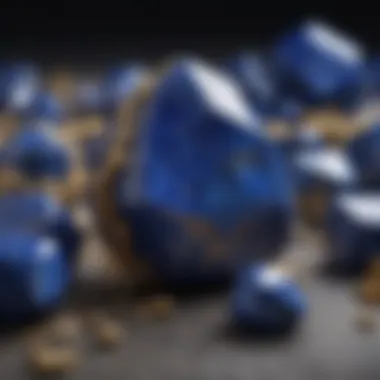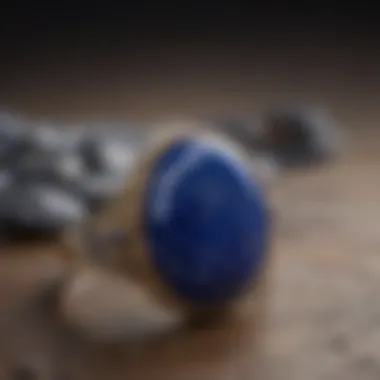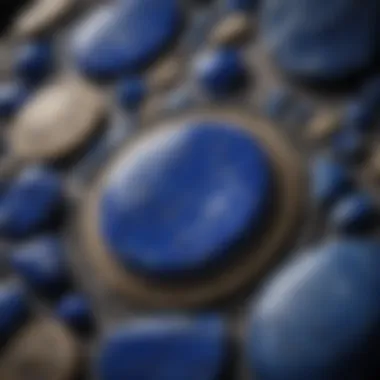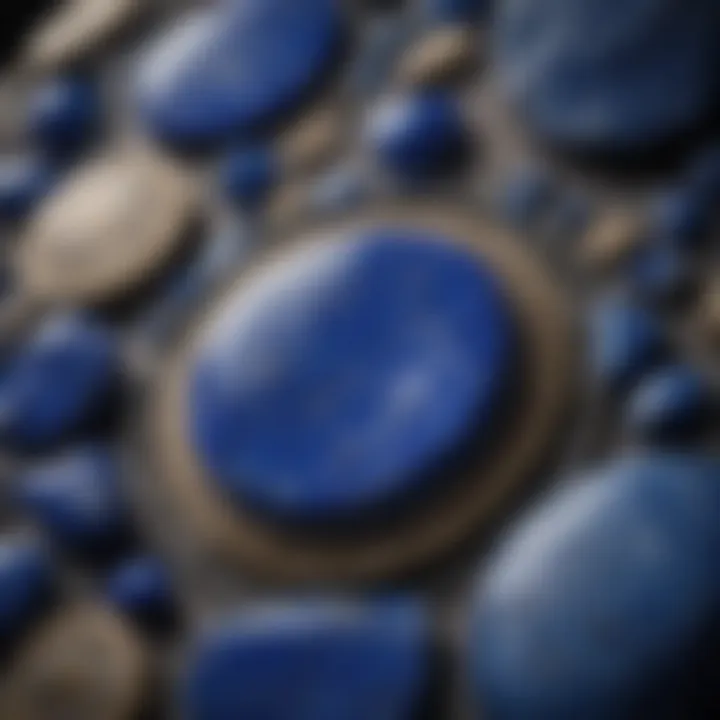Exploring Lapis Gemstone: History, Value, and Care


Intro
Lapis lazuli, a deep blue gemstone with a history that stretches back thousands of years, is often seen as more than just a stone. It embodies stories of civilizations, art, spirituality, and even trade. For the collector or the casual enthusiast, understanding lapis also means tapping into an extensive historical narrative that encompasses its geological formation and cultural relevance.
From the dusty valleys of Afghanistan, where some of the finest lapis has been mined for millennia, to the crowded marketplaces of contemporary artisan jewelry, this gemstone highlights a connection between the past and present. Whether you intend to add a stunning piece to your collection or use it in artistic endeavors, understanding the intricacies of lapis lazuli elevates the appreciation far beyond mere aesthetics.
As we explore this vibrant stone, we will dive into various dimensions—from its geological roots to its socio-cultural significance, and practical aspects like preservation and identification techniques—all designed to serve the discerning eye of rock and fossil collectors.
Let’s embark on this journey through the world of lapis lazuli, unveiling its numerous facets that continue to captivate many today.
Foreword to Lapis Gemstone
Lapis lazuli, a gemstone often vibrant and deep blue, is more than just a pretty rock. It carries with it a wealth of history, cultural significance, and geological wonders that attract enthusiasts and collectors alike. This section lays the groundwork for the exploration of lapis gemstone by providing a definition and an overview of its essential characteristics.
Definition and Overview
Lapis lazuli isn’t just one mineral; it’s a rock composed mainly of lazurite, a blue silicate mineral. It might also have small flecks of pyrite, giving it a sparkly look, and calcite, enhancing its unique charm. The color can vary, with some specimens showcasing royal blues, while others may have hints of violet or green. Its name traces back to the Latin word for "stone" and the Arabic word "lazaward," denoting its celestial hue.
The allure of lapis extends beyond aesthetics. It has been valued for its use in jewelry and decorative items for thousands of years, creating a niche both among artisans and collectors. For instance, ancient Egyptians revered lapis due to its association with the heavens and frequently used it in burial ornaments. This reflects not only its beauty but also its perceived spiritual significance.
Historical Significance
The history of lapis lazuli is as colorful as its appearance. Ancient civilizations—think Egyptians, Mesopotamians, and even the Chinese—sought this gem for various purposes, from ornamental to utilitarian. Lapis was used in amulets, scarabs, and even as a pigment in art during the Renaissance, showcasing its versatility.
"Lapis lazuli has adorned royal tombs and sacred artifacts, symbolizing wealth and power since as early as 4000 BC."
In many cultures, lapis lazuli was believed to bestow wisdom and protection, leading to its association with the divine. The connection to deities reflects the gemstone’s prestigious status throughout history. Notably, it served as a favorite of the Pharaohs, and its unique color was often linked to the afterlife, a meaningful aspect when considering the lavish burial practices of the time.
Understanding the power and allure of lapis lazuli invites us to appreciate its geological roots and the cultural fabric that has embraced it for millennia. As we navigate through this article, it becomes clear that lapis lazuli is more than just a gemstone—it is a testament to human creativity, belief, and the enduring quest for beauty.
Geological Characteristics
Understanding the geological characteristics of lapis lazuli provides a foundational insight into its unique properties and significance. This knowledge is imperative not only for collectors and enthusiasts but also for jewelers and artists who seek to harness the beauty and essence of this stunning gemstone. Exploring its formation, mineral composition, and geographical distribution grants a clearer picture of why lapis lazuli stands out among precious stones.
Formation of Lapis Lazuli
Lapis lazuli forms under specific conditions primarily found in metamorphic rock environments. It originates from a unique blend of minerals that come together through geological processes over millions of years. The formation typically takes place in pockets within metamorphosed limestone or marble where subduction forces cause intense heat and pressure. This environment allows for the transformation of primary minerals like sodalite and lazurite.
The multi-step formation of lapis lazuli begins when volcanic activity introduces silica and other elements into existing rock formations. As these rocks undergo metamorphism, they interact with various fluids rich in sodium and aluminum. Eventually, through this intricate dance of elemental interaction and temperature stabilization, lapis lazuli crystallizes into its distinctive, deep blue hue. The presence of gold pyrite flecks within the stone often contributes to its allure, adding to the decorative flair that has enchanted cultures throughout history.
Mineral Composition
The mineral composition of lapis lazuli is complex and varies among specimens. The primary ingredient is lazurite, which gives the stone its rich blue coloration. In addition to lazurite, lapis lazuli typically includes several other minerals, such as calcite and sodalite, which can affect its overall appearance.
- Lazurite: The dominant mineral that imparts the blue color characteristic of lapis lazuli.
- Calcite: Often presents as white streaks and inclusions, providing contrast to the deep blue background.
- Sodalite: Contributes to the stone’s color and may be found in varying amounts, influencing the final appearance of the gemstone.
- Pyrite: Frequently found scattered throughout the stone, giving it a sparkling effect that enhances its beauty.
Each of these minerals plays a role in determining the final value of the stone. Higher concentrations of lazurite and the visibility of pyrite inclusions are often sought after in the market. Recognizing these components helps collectors and gem traders identify high-quality specimens.
Geographical Distribution
Lapis lazuli is predominantly sourced from regions rich in metamorphic rocks conducive to its formation. Afghanistan remains the most renowned location for high-quality lapis lazuli, particularly from the Badakhshan province, where the stone has been mined for over 6,000 years.
Other notable sources include:
- Chile: The lapis lazuli found here is often lighter in color, but still carries some of the distinctive aesthetic qualities.
- Russia: Particularly in the Ural Mountains, where unique deposits of lapis lazuli have been discovered.
- Italy: Known for producing lapis with high-grade lazurite content, often used in fine art.
The mining practices in these regions vary, with some relying on traditional methods while others adopt modern mining techniques. This geographical diversity not only enriches the gem's story but also impacts its availability and market trends.


"Lapis lazuli is a treasure trove of history and beauty, steeped in a geological journey that's as fascinating as its vibrant blue color."
Understanding these geological aspects adds depth to the appreciation of lapis lazuli. From its formation and composition to its various sources around the globe, each layer unveils an intricate story about this ancient gem.
Cultural and Historical Context
The cultural and historical significance of lapis gemstone cannot be overstated. It is not just a beautiful mineral but a symbol of human expression across various eras. The deep blue of lapis lazuli has enchanted artists, jewelers, and civilizations for millennia, revealing layers of meaning and value that are pivotal in understanding its role in society.
Lapis in Ancient Civilizations
In ancient times, lapis lazuli was a gem of status, often reserved for the elite and used in artifacts meant to signify power. The Mesopotamians, for instnace, considered it a gift from the gods. They utilized lapis in their jewelry, sculptures, and even religious items. Sumerians would grind the stone to produce pigment for their artworks, creating a vivid cobalt blue that expressed opulence.
Artifacts such as the funerary mask of Tutankhamun in Egypt, which incorporates lapis lazuli, symbolize the intertwining of the mineral with wealth and spirituality. Many cultures, including the Greeks and Romans, valued lapis not just for its beauty but also believed it possessed protective qualities, warding off evil.
Symbolism and Use in Art
All through history, lapis has maintained a dual identity: a commodity of beauty and a medium of spiritual significance. It has frequently been associated with wisdom, truth, and nobility. Artists felt compelled to incorporate this gem into their work as they believed it possessed an essence that could elevate their creations.
In medieval Europe, lapis lazuli was ground into powder and used in illuminated manuscripts. The bright blue color became synonymous with divinity, often appearing in depictions of the Virgin Mary. Its striking hue is also regarded as a bridge to the celestial world, adding depth and meaning to art beyond mere aesthetics.
"The use of lapis in art is not just about color; it’s a dialogue between the material and the spiritual, between earthly and divine.“
Modern Cultural Usage
As we stride into the modern era, the significance of lapis continues, though its context has evolved. Today, it finds a place in the wardrobes of those who appreciate its historical depth and stunning beauty. Contemporary designers utilize lapis lazuli in various forms—from high-end jewelry to statement fashion pieces. Its texture and deep blue hue resonate well within the realms of handmade artisan crafts.
Moreover, lapis lazuli is leveraged in holistic practices. Many individuals believe it enhances intuition and mental clarity; thus, it’s commonly found in wellness retreats and spiritual occasions. The gemstone also garners attention in social media circles, where enthusiasts share their collections and insights about its beauty and symbolism.
Through every phase of history, lapis lazuli has maintained its allure, weaving into the fabric of various cultures, symbolizing more than just a physical stone. Its journey from ancient civilizations to the modern day showcases its resilience and importance, making it a fascinating topic for collectors and scholars alike.
Valuation and Market Trends
Valuation and market trends offer valuable insights into the lapis gemstone from multiple angles, shedding light on how this stunning stone's worth is determined in various contexts. As rock and fossil collectors increasingly gravitate towards unique specimens, understanding these trends enables them to make consummate purchasing decisions. Additionally, this information aids in tracking shifts in demand, which can impact a collector's investment portfolio significantly. The lapis gemstone, known for its deep blue hue and historical significance, stands as a noteworthy player in the gemstone market, making its valuation all the more pivotal.
Factors Affecting Value
Several elements contribute to the valuation of lapis gemstones, each reflecting the particular qualities and features that enthusiasts and collectors cherish. The principal factors include:
- Color Saturation: The depth and uniformity of the blue color heavily influence the stone's value. Rich, vibrant blues that display little to no pyrite inclusions tend to fetch higher prices.
- Quality of the Stone: This encompasses factors such as clarity and texture. A smooth, polished finish combined with minimal imperfections enhances a stone's desirability.
- Origin and Provenance: Certain locations, especially Afghanistan, are famed for producing high-quality lapis lazuli. Stones sourced from these areas may command higher prices due to their reputation for excellence.
- Size and Carat Weight: Larger specimens naturally attract higher valuations, provided other quality factors are met.
The nuances surrounding authenticity and quality mean that proper identification and appraisal are essential for both seasoned collectors and newcomers alike.
Current Market Trends
The lapis gemstone market is witnessing intriguing trends that reflect broader societal movements, including a growing interest in sustainable and ethically sourced materials. Some noteworthy trends include:
- Sustainable Sourcing: With increased awareness of environmental issues, collectors are leaning towards lapis lazuli that comes from ethically responsible operations. This trend is reshaping how companies source their products and communicate this information to potential buyers.
- Online Sales and Auctions: The rise of online marketplaces has transformed how lapis gemstones are bought and sold. Platforms like eBay and dedicated jewelry websites have expanded the reach of both buyers and sellers, creating a vibrant ecosystem for gemstone enthusiasts.
- Crossover with Other Markets: Lapis lazuli is increasingly finding its way into unexpected realms such as fashion and interior design. Designers are incorporating lapis in jewelry lines as well as using it in home décor, elevating its status beyond traditional markets.
- Investment Potential: More collectors are contemplating lapis lazuli as a viable investment option, especially as the demand for unique and rare gemstones continues to rise.
"The value of lapis lazuli is not just in its beauty, but in its story – a tale of natural wonder that can captivate anyone who appreciates art, culture, and history."
The lapis gemstone market is rich with potential, reflecting both its timeless allure and evolving market dynamics, making it a fascinating study for any collector.
Jewelry and Artistic Applications
Lapis lazuli is not merely a stone; it embodies a rich tapestry of culture and artistry that intertwines across history. This section sheds light on the importance of lapis in jewelry and decorative arts, showcasing both its beauty and its historical weight. The allure of lapis lies not just in its deep blue hue speckled with flecks of gold and white but also in its ability to fit harmoniously in various artistic expressions.
Use in Fine Jewelry


The role of lapis lazuli in fine jewelry is significant. Historically, it has adorned the necks, wrists, and ears of the elite. Its breathtaking deep blue color symbolizes luxury and wisdom. The gemstone speaks volumes about the status of those who wear it. One of the standout qualities of lapis is its versatility. Unlike many gemstones that require faceting to showcase their splendor, lapis shines in its raw nature, often polished smoothly to let its natural beauty emerge.
When considering lapis for fine jewelry, a few key elements come into play:
- Durability: Lapis holds up well, rating about 5 to 6 on the Mohs scale, making it suitable for everyday wear in rings and necklaces.
- Design Compatibility: It works well in various settings: gold, silver, or even mixed metals.
- Symbolism: Its use in jewelry often reflects the wearer's desire for wisdom and self-discovery, which connects to its historical use in cultures that revered it.
For collectors, investing in lapis jewelry is not just about the visual appeal; it’s about acquiring pieces that tell a story and reflect on the craftsmanship involved.
Integration in Decorative Arts
Beyond personal adornment, lapis lazuli finds itself embedded in decorative arts throughout history. From ancient Egypt to the Renaissance, artisans used this gemstone in various creations. Lapis has often been ground into a fine powder and mixed with binders to produce a vivid shade of blue paint, known as ultramarine. This pigment has graced the masterpieces of many renowned artists.
The integration of lapis in the decorative arts is notable for several reasons:
- Artistic Technique: Application of lapis lazuli extends to mosaics and intarsia work, where small pieces are arranged to create intricate patterns or images, giving depth to the tactile experience of art.
- Cultural Significance: Much like in jewelry, decorations adorned with lapis reflect a culture’s appreciation for beauty and permanence, making it a favored material in temples, sculptures, and artifacts.
- Legacy: The stone’s long-standing popularity in decorative arts speaks volumes about its perceived value over centuries, cementing its place in history.
The artistic journey of lapis lazuli showcases not only its intrinsic beauty but also its capacity to transcend time, bridging the past and present in a vibrant dialogue of color and form.
In summary, lapis lazuli is more than decorative means; it's a window into human expression and creativity, telling stories of civilizations and the people within them. It stands as a testament to the relationship between nature’s gifts and human artistry.
Care and Preservation
Taking good care of lapis gemstone is essential for maintaining its stunning appearance and historical value. This gemstone, with its deep blue hue and intricate golden flecks of pyrite, is not only prized for its beauty but also holds significant cultural and historical relevance. Proper care ensures that collectors can showcase their pieces for many years to come.
Cleaning Techniques
When it comes to cleaning lapis lazuli, one must tread lightly. While it is a relatively tough stone, it does require some finesse to avoid damaging the surface. Here are some effective approaches to keep your lapis sparkling:
- Gentle Soap and Water: Mix a few drops of mild dish soap in lukewarm water. Using a soft cloth or a sponge, gently wipe the surface of the gemstone. Avoid any harsh chemicals or cleaners as these can dull the stone’s finish.
- Avoid Abrasives: Never use abrasive pads or scrubbing brushes which can scratch and mar the stone’s surface.
- Soft Brushes: For crevices or any intricate designs, a soft-bristled toothbrush can do wonders without being too rough.
- Rinse and Dry: After cleaning, rinse the gemstone thoroughly with clean water. Use a soft towel to pat it dry, ensuring that no residual moisture is left, as water can accumulate in cracks and cause issues.
"Your lapis lazuli is not just a stone; it's a slice of history waiting to shine bright with your care."
Storage Recommendations
Storing lapis lazuli properly is just as crucial as cleaning it. The way you store your gem can prevent scratches and preserve its quality over time. Here are some tips for optimal storage:
- Separate from Other Jewelry: If you keep your lapis alongside other gemstones, ensure they are in separate pouches or compartments. It’s all too easy for harder stones to scratch the surface of lapis lazuli.
- Soft Pouches or Wraps: Use soft, protective cloths or pouches made from materials like silk or velvet. This prevents unwanted friction and dust accumulation.
- Avoid Direct Sunlight: Lapis can fade over time if exposed to direct sunlight. Store it in a cool, dark place that minimizes exposure to harsh light conditions.
- Humidity Control: Maintaining moderate humidity is important, as excessive moisture can weaken certain mineral compositions. Consider using silica gel packets in storage boxes to keep humidity levels in check.
By following these simple yet effective care and preservation practices, collectors can ensure their lapis gemstones retain their extraordinary beauty and cultural significance. This thoughtfulness not only enhances the visual impact of the gemstone but also adds to its longevity, making sure it can be appreciated for generations.
Identification and Authentication
The realm of lapis gemstones, rich in history and appeal, also poses the challenge of identification and authentication. With the rise in popularity and value of lapis lazuli, more collectors and enthusiasts are venturing into understanding how to discern genuine stones from imitations. The significance of mastering these skills cannot be overstated; counterfeit stones not only affect the market value but also the integrity of one’s collection. Thus, becoming knowledgeable about the unique features and testing methods of lapis is essential in ensuring that investments are sound and authentic.
Physical Attributes to Observe
When it comes to identifying lapis lazuli, keen observation plays a pivotal role. Here are some of the key physical features to keep an eye on:
- Color Variability: True lapis lazuli has a vibrant blue hue, often with striking gold flecks of pyrite, resembling tiny stars scattered in the night sky. A mere all-blue stone might indicate a fake.
- Texture: Genuine lapsis exhibits a rough texture with a slightly waxy feel. Some lapis may appear smooth, though that usually points to over-polishing, affecting its natural beauty.
- Inclusions: Take a close look for its characteristic white calcite veins or specks of gold pyrite. Absence of these can suggest it's not the real deal.
- Weight: A genuine lapis lazuli stone is somewhat heavy compared to typical counterfeit materials, such as plastic or dyed stone.
- Transparency: Hold the stone up to a light source; authentic lapis lazuli will not be fully transparent. If light passes through too easily, it’s probably a fake.
Testing for Authenticity
Once physical attributes have been assessed, consider further testing methods for a more foolproof means of guaranteeing the authenticity of lapis lazuli:
- Ultraviolet Light Test: Real lapis generally doesn’t fluoresce under UV light. If the stone glows, it may be dyed or made from another form of imitation.
- Scratch Test: Lapis lazuli has a hardness rating of around 5 to 5.5 on the Mohs scale. If it scratches easily with something like glass, it signifies a counterfeit.
- Density Measurement: Weigh the stone and divide it by its volume. Genuine lapis has a density of about 2.7 g/cm³, which is higher compared to many imitators.
- Professional Appraisal: When in doubt, consulting with a professional gemologist who specializes in lapis can provide reassurance. They can conduct advanced testing methods, such as spectroscopy.
Mastery of identification and authentication techniques enhances your engagement with this stunning gemstone while promoting responsible collecting practices.


Environmental and Societal Impact
Understanding the environmental and societal impact related to lapis gemstone is crucial for appreciating its full narrative. As a highly sought-after mineral in jewelry and decorative arts, lapis lazuli's extraction and processing raise various ecological and ethical questions that need to be examined closely. Considering these aspects brings to light not just the beauty of lapis, but also the practices behind its journey from the earth to art forms, and the potential ramifications for communities involved.
Mining Practices
Mining for lapis lazuli is primarily concentrated in Afghanistan, particularly in the Badakhshan Province. Here, mining not only taps into a rich geological resource but also intertwines with the lives of the local populace. Traditional extraction methods often involve hand tools and are labor-intensive. This might seem quaint, but it can lead to significant environmental degradation if not managed responsibly.
Moreover, the demand for lapis has led to an increase in mining activities, sometimes ignoring sustainable practices. Runoff from mines can contaminate water sources, impacting agriculture and health of the nearby communities. Thus, it's imperative to push for regulations that promote responsible mining, ensuring that the natural landscape and local water systems are preserved.
"Mined resources can bring prosperity, but if mismanaged, they can lead to irreversible ecologic damage."
Cultural Sustainability Efforts
On the flip side, the extraction of lapis lazuli also opens avenues for cultural sustainability. Initiatives aimed at ensuring that the benefits of mining reach the local communities can help maintain their cultural heritage. For example, some companies and NGOs are advocating for fair trade practices that allocate a portion of proceeds to community development projects, education, and healthcare.
Another aspect to consider is the craftsmanship associated with lapis lazuli. Various small-scale artisans and craftsmen create intricate designs and jewelry, contributing to the local economy and preserving traditional skills that have been passed down through generations. Supporting these artisans not only enriches consumer experience with unique pieces but also ensures that the cultural significance of lapis is upheld within the community.
Future Trends in Lapis Use
The world of lapis gemstone is constantly evolving, with new trends emerging in various fields. As our understanding of this beautiful mineral deepens, its applications continue to expand, offering a wealth of opportunities for both collectors and artisans. This section delves into the future of lapis, highlighting emerging technological applications, innovative design perspectives, and the broader implications of these advancements.
Emerging Applications in Technology
Lapis lazuli has traditionally been regarded for its beauty and cultural significance, but recent innovations are paving the way for its use in technology. The relationship between precious stones and science is becoming clearer; scientists are discovering that the unique properties of lapis can be applied in fields such as optics and electronics.
For instance, the striking blue pigment derived from lapis is being explored for use in high-quality coatings and dyes. Researchers are investigating how this pigment can enhance the durability and aesthetic appeal of consumer electronics, from smartphones to laptops.
Another intriguing use is in the field of astrobiology. Lapis is being considered in research related to extraterrestrial environments due to its resistance to wear and its chemical stability. The belief is that materials like lapis can withstand harsh conditions found on other planets. This places lapis in a unique spot within interdisciplinary studies.
Here are some potential technological applications of lapis lazuli:
- Optical Sensors: Utilizing the mineral’s color-changing properties in sensors that respond to environmental conditions.
- Durable Absorbents: Developing filters that leverage lapis for purifying air or water.
- High-Performance Paints: Using lapis-derived pigments in paints that require durability and color retention in extreme conditions.
Innovative Design Perspectives
The aesthetic appeal of lapis is undeniable, and designers are harnessing this beauty to create contemporary pieces that blend tradition with modernity. The trend of sustainable and ethical fashion is significantly impacting how lapis is utilized in design. More artists and jewelers are focusing on the sourcing of materials, seeking responsibly mined lapis for their creations.
In jewelry, designs incorporating lapis are becoming increasingly popular. Pieces are not just about showcasing the gemstone but integrating it with other materials in a way that highlights its deep, celestial blue. Many designers are employing minimalist aesthetics, allowing lapis to take center stage in a more understated manner.
Similarly, the interior design space is seeing a resurgence in the use of lapis lazuli in decorative arts. From inlays in furniture to striking accent pieces, the rich color of lapis is perfect for creating a luxurious atmosphere in both residential and commercial environments.
The following are some innovative design trends involving lapis:
- Mixed Media: Combining lapis with materials like wood, metal, or glass for a more dynamic look.
- Eco-conscious Art: Focusing on the incorporation of sustainably sourced lapis into artistic expressions, emphasizing responsible consumerism.
- Statement Accessories: Utilizing lapis in large, bold pieces that resonate with modern sensibilities while preserving the old-world charm it represents.
"Embracing the beauty of lapis lazuli in modern design is not just about aesthetics; it’s about telling a story of heritage and craftsmanship in an age of innovation."
Finale
Understanding the lapis gemstone is not just an academic pursuit; it encapsulates a rich tapestry of history, culture, and artistry that has captured human fascination for centuries. This article has sought to illuminate several key aspects of lapis lazuli—from its geological makeup to its diverse applications in jewelry and fine arts.
Summarizing Key Insights
To summarize, lapis lazuli stands out due to its vibrant deep blue hue, a characteristic that has rendered it a prized possession across various cultures and eras. It is a fascinating composition of minerals, primarily lazurite, calcite, and pyrite, contributing not only to its visual appeal but also to its unique symbolism throughout history. The gemstone has traversed time, depicting the grandeur of ancient civilizations while still finding relevance in today's modern contexts.
- Geological Traits: The formation, mineral composition, and geographical distribution have solidified lapis as a genuine geological marvel.
- Cultural Significance: Its significance extends beyond mere aesthetics, translating into various forms of art and symbolizing power and spirituality in multiple ancient cultures.
- Market Trends: The current market dynamics highlight the increasing appreciation for lapis within both the collector’s sphere and general market spaces. As demand rises, understanding the value determinants becomes crucial for those interested in these gemstones.
Implications for Collectors and Hobbyists
For collectors and hobbyists, the insights from this article offer numerous implications. Knowledge of lapis lazuli’s value and its historical context can significantly enhance the experience of collecting. Understanding how to identify authentic pieces and the appropriate care techniques are vital for preserving the integrity and value of this gemstone.
- Collecting Tips: Knowing the differences between natural and synthetic lapis can prevent costly mistakes when purchasing. Understanding the grading systems can also help in assessing the quality of pieces before buying.
- Networking Opportunities: Engaging in discussions on platforms like reddit.com or facebook.com brings opportunities to connect with fellow enthusiasts, share insights, or even trade pieces.
- Appreciation of Artistry: Beyond just collecting, recognizing the craftsmanship and history behind each piece can deepen appreciation, transforming a hobby into a passionate pursuit.



